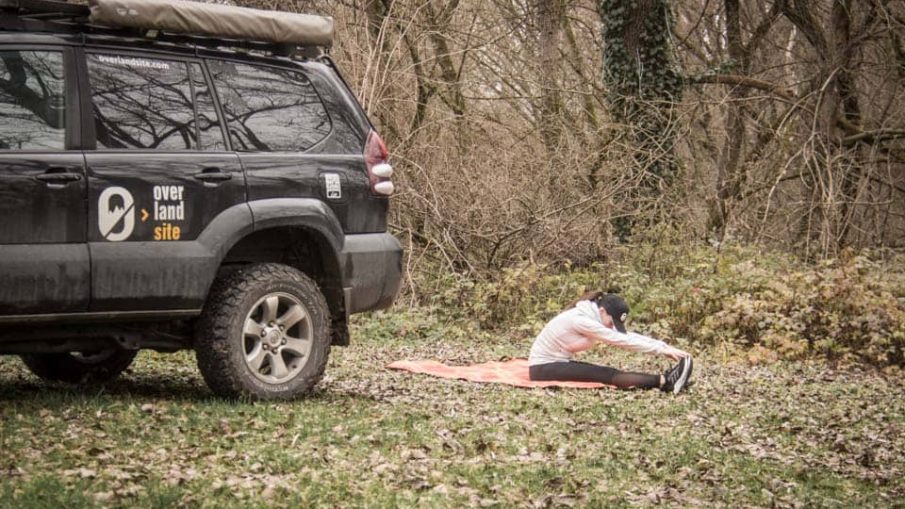Ever wondered who an overlander is or the word ‘overlanding’ means?
Here you go…
An Overlander is one who travels over lands or countries; one who travels overland. Overlanding is self-reliant overland travel to remote destinations where the journey is the principal goal. Typically, but not exclusively, it is accomplished with mechanized off-road capable transport (from bicycles to trucks) where the principal form of lodging is camping, often lasting for extended lengths of time (months to years) and spanning international boundaries.
Makes sense?
In the article originally published on overlandsite.com, we explore some exercises to remain fit on months-long road-trips.
If you’re an overlander, (or truck driver, or live in an RV), you spend a significant amount of time driving. It’s easy to neglect your health. Some of the health risks drivers face are:
- Obesity,
- Heart disease,
- Diabetes,
- High blood pressure,
- Depression.
The lack of general routine can also lead to neglecting your exercise routine. Exercise improves both mental and physical health. Overlanders should make an effort to establish a routine and exercise daily to avoid these health risks. Doing aerobics every day continuously works on your larger muscle groups, gets the blood flowing, and maintains a natural rhythm.
If you spend just thirty minutes a day exercising, you’ll gradually improve your health. After a long day of sitting in your cab, even stretching helps strengthen your muscles. The long hours you work are very tough. You don’t have to tackle it all at once. Take small steps to accomplish your health goals. Improving your diet combined with exercise will help you on your journey to living healthy.
Below are some exercises you can do daily while on the road. These exercises work all the muscles in your body, including your lower back.
For drivers, working on the lower back is essential. One of the leading causes of drivers experiencing lower back pain is sciatica. Oddly enough, sciatica doesn’t start in your back. The sciatica nerve is on the back of your leg. Sitting for long periods can pinch the nerve.
Now, let’s explore some exercises you can do while out on the road driving. To decrease your chance of getting injured, warm-up before you exercise. It also:
- Reduces muscle tension
- Increases the flow of oxygen and blood
- Gives you a better range of motion
- Increases your flexibility
- Prepares your muscles for exercise
1. Warmup
First, start by stretching. While standing, take the tips of your fingers and touch your toes. Hold this position for ten seconds, then release. Do this stretch five times before moving forward. Also, wait ten seconds between stretching to rest your muscles. Next, sit on the ground with your legs crossed.
Lean forward as far as you can and hold for ten seconds. Do this stretch five times before going to the next step. After stretching your arms, legs, and lower back, run in place for two minutes. Running in place will get your heart pumping and blood flowing. You can use resistance bands while stretching or jump rope instead of running. After that draw 10 circles in the air using every part of your body going from your head down to your ankles.
2. Push-ups
This exercise works your core, arms, chest, and shoulders. Push-ups give you an overall rating of your fitness. You can gauge whether you need to work out more.
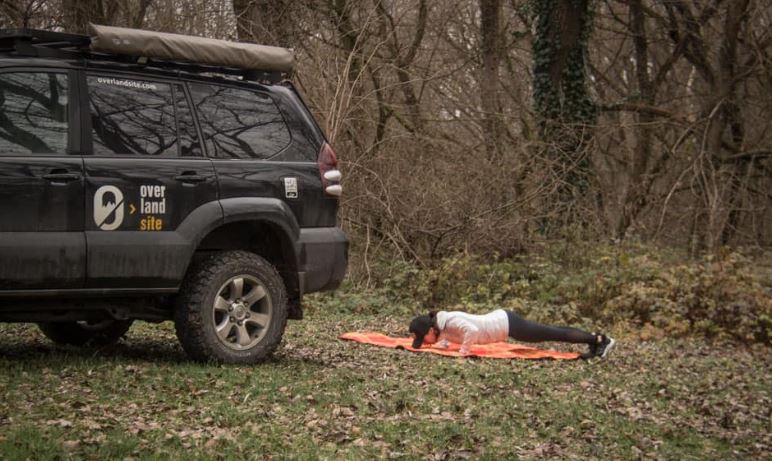
To do a push-up, get on the ground on all fours. You want to position your hands out wider than your shoulders. Extend your legs straight out and balance your body weight on your toes and hands. Keep your body straight. Don’t sink or arch your back. For every push-up, keep your core tight. When you bend your elbows to go down, inhale slowly. Exhale as you lift yourself back up. Never lock your elbows. For starters, do ten sets of five. When you get stronger, add more reps.
As an alternative to push-ups is the TRX Chest Fly. If you have a resistance band, anchor it and face away from it. With both hands, grab the resistance band and extend your arms. Lean forward and spread your arms out like a T.
3. Sit-ups
Sit-ups work your core, neck, chest, and obliques. Doing sit-ups helps to balance your body. The muscles in your hips and stomach become stronger. Also, the muscles in your legs, abdomen, and arms become more stable.
Sit-ups are a perfect exercise to maintain your posture. Sitting all day can change your posture. Sit-ups are a cost-effective way to give you perfect posture.
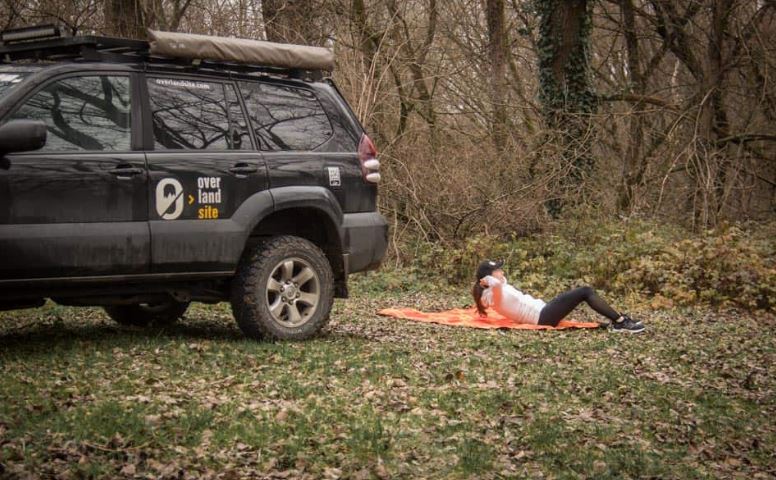
Lay on your back and bend your legs. Place your feet flat on the ground. Cross your arms on your chest or behind your head. Do whichever is more comfortable for you. If you place your hands behind your head, don’t pull on your neck doing sit-ups. Bring your upper body up to your knees and exhale while you lift. When you lower your body back down, inhale slowly. Do ten sets of five. Allow your body to tell you when you’re strong enough to add more reps.
4. Jumping Jacks
Jumping jacks give you a full-body workout. They target all your major muscles. You can do them anywhere, and you don’t need any equipment. Jumping jacks is a cardiovascular workout.
It is also called a plyometric exercise. Plyometrics are explosive and involve jumping. They increase power, quickness, and speed. Jumping jacks can also be beneficial to your bones. By doing a regimen of jumping jacks every day, you’ll be strengthening your bones and lower back. Over the years, we lose bone density. Mitigate the loss with jumping jacks.
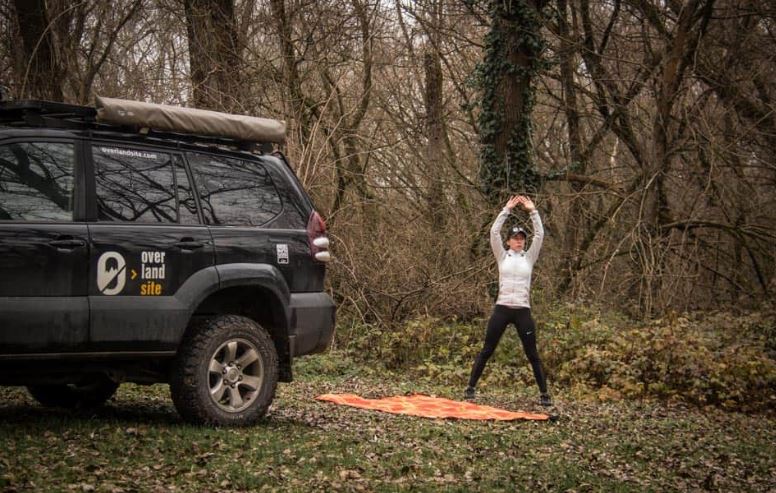
Stand up, put your arms down by your side, and keep your legs together. Bend your knees and jump. When you jump, spread your legs apart. Raise your arms, in the air, over your head simultaneously. Jump again, and return to the position you started in. As with all the exercises, do ten sets of five until you’re comfortable doing more.
5. Dips
Dips are a compound exercise that uses your body weight. They work your anterior deltoids, chest, and triceps. Dips strengthen the whole upper body. Other resistance exercises only work one muscle. You don’t need a gym to do this exercise. You can do them anywhere.
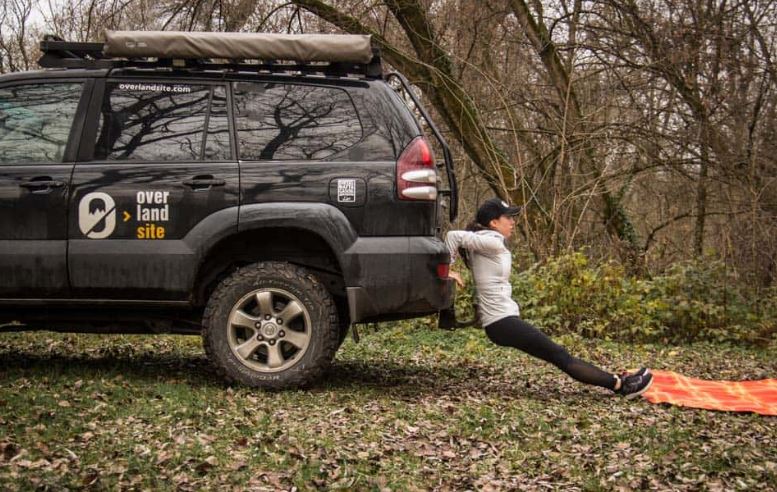
You can use the front or back bumper of your truck or an even lower platform for this exercise. To do a dip properly, turn your back to your truck. Put your legs out in front of you, and put your hands on the bumper. As an alternative, you can use any of the following as a platform: a spare tire, cooler box, Wolf Pack-type box, etc. But make sure the platform is stable! Most of your body weight should be on your arms. Bend your elbows and dip down until your glutes touch the ground. Lift your body back up. Don’t forget to lock your elbows when you lift.
Resistance extensions benefits are the same as dips. It’s a great alternative. Put your right foot in front of your left foot. Put the band under your left foot. Extend your arms up and put the bands behind your head. Lower your arms to complete the rep.
…and there is more. Follow the link overlandsite.com to read up. It’s important you find a safe spot to do your exercies.
